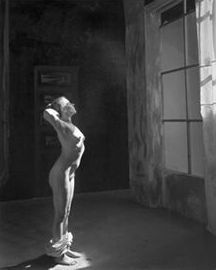
Kim Weston -Nude in the Window
Kim Weston
Kim Weston photographs almost exclusively in a small studio at his home near Carmel, California. He designs and builds elaborate sets, adds models and photographs them with an 8x10 view camera. He makes a limited number of large prints from his negatives.
Kim has a distinguished heritage. His Grandfather Edward Weston was one of the finest photographers of the 20th century. His Uncle Brett’s photographs demand high prices at auctions and galleries. His father, Cole, is still photographing and teaching workshops at age 81. Cole’s ex-wife Maggie owns the Weston Gallery in Carmel, one of the premier galleries of photography.
Kim, his wife Gina and their son Zachary live in the house Kim’s Uncle Neil built for Kim’s Grandfather Edward. The house has changed little since Edward Weston died there in 1958. Edward’s darkroom is there and I am filled with awe at the thought of the magnificent images that were printed in it. Kim has built his own darkroom and studio in separate buildings on the property. The property sits on a hillside overlooking the Pacific Ocean. Point Lobos is only a few minutes away.
Photographers are often faced with the choice of making their work more profitable by appealing to the public’s taste or remaining true to their vision and selling less work. Kim has resisted the pull of the almighty dollar and remained true to his art. He supports his family by working as a carpenter.
I spoke to Kim at his home on a beautiful Sunday afternoon.

Kim Weston -Nude in the Window
BR: I am interested in talking about your vision. You have a unique approach to photography. Maybe you can start by telling me how you work; what your process is.
KW: It is funny you mention that because today I was working on the studio and all of a sudden I had a clear insight into what I do and how, in a lot of ways, it is very, very immature for the person I am. I mean for what I record mentally upstairs and how it transforms to the visual picture. It’s almost like my equipment, it’s very archaic. Maybe I was thinking that way because we’ve been dealing with computers and this rapid, fast stuff and this new digital camera that I got. I can instantly record my feelings, my emotions, digitally with the camera. But I have for so many years done the classic 8x10 format. I draw out all my little sets and everything and I was thinking, "God is that me?" "Am I that archaic?" Archaic is not the word but simplistic, and I think I really am. I think it is very important for me to go through those processes, leading up to the finished print, that are not instantaneous like with the digital camera. The hours that I spend formulating the idea and drawing the idea, the camera ends up being just a second of recording those ideas. No matter how fast I could do it with the digital camera I don’t think I would get the same thing out of it. The passion I have for formulating an idea stands alone. It is the important essence of what I do.
I was mulling that over in my brain and I was thinking "God! With a digital camera [you could shoot as quickly] as you come up with all these ideas."
I was thinking of a new series. I have this bird wing. I’m going to put it on a box, a box with a lock on it. I have, I don’t know if you saw down in the studio, a little wing on the top of a box and to me it is very Magritte. He did all those surrealistic paintings where objects are just juxtaposed. I was thinking about it and thinking about it and I have this great wing and this great box. To me, that is the essence of me as a photographer. It is those ideas, working with them, formulating them and eventually putting them down on paper, photographing them and then going on to the next step. I think the digital camera would record that information too fast for me. I’m a slow person. My vision is that way, it has become that way to fit my personality.
I think all photographers fit their vision to their personality. Some love to do it fast, some love to take more time, some love just darkroom work. Some just like the technical aspect of it. I don’t. I like the process before the darkroom. The darkroom is just the means to an end. I love to go down to the studio and create a new thing.
BR: I looked at some of your early work and it has evolved quite dramatically. You have gone from sort of a high key style and your more recent work seems very dark in overall tone.
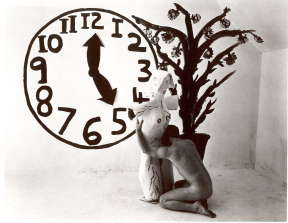
Kim Weston - Self-Portrait (1988)
KW: Subject matter? The subject matter is insane. And it’s interesting because I was playing with that same idea-- looking at what I photographed 15 – 20 years ago when I started doing studio work. I don’t know, the older I get, the more complicated I think I get, which is a hindrance. I would much rather go back and photograph with the innocence I had when I was younger. I think that’s what you’re seeing in the work, a lot more layers to it. The edges are not as sharp. For an artist it’s a progression and a period that I’m going through. What an artist tries to do is to go back to that youth, to that inspiration, that excitement. Especially at my age, when you get a couple of good images that people just love and they’ve got to have. As an artist, philosophically you think, if they’ve got to have it then you’re doing something wrong. It’s a battle.
BR: I look at a lot of photographer’s work and they get something that sells and all of a sudden that’s all they produce. Other photographers slide into that commercial "I’m going to do picture postcard kind of stuff." You seem to have worked pretty hard to avoid that.
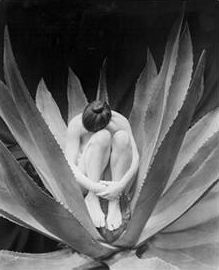
Kim Weston - Aloe Nude |
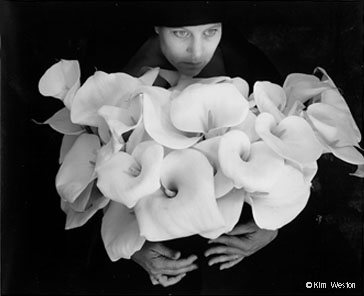
Kim Weston - Calla Lilies |
KW: Exactly. If something is successful then I’m doing something wrong. Because I don’t use the public as a judge of my best work. I just don’t. Not that I go out of my way to make it different if an image is good. I know I do good work in that vein, like Aloe Nude and Calla Lilies and stuff like that. But, I question myself constantly if something is a success, as those are. Because I’ve seen it done too many times before, done to my grandfather, where all everyone remembers of him is Pepper 30, Nude in a Doorway, a few great images. And it happened to my Uncle Brett too. Holland Canal is probably his most famous and it wasn’t even his happiest photograph. He says it’s a good photograph. That didn’t keep him from printing sixty of them in a morning. I don’t know, it’s a struggle. I think we all find what makes us happy.
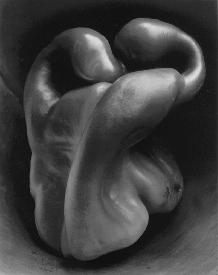 Edward Weston - Pepper 30 |
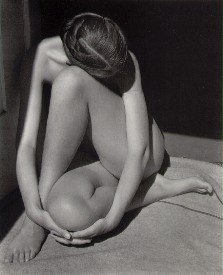
Edward Weston - Nude in Doorway |
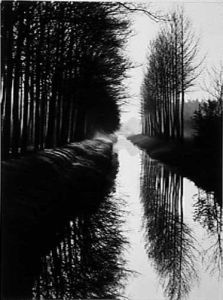
Brett Weston - Holland Canal |
BR: Maybe we all try to find it.
KW: Yes. In our medium certain people don’t dig as far and it’s obvious in their work. Like you said it goes to a certain stage, it’s successful and what is success? Success is not judged by the public. Success is judged by how you feel when you finish something, to hell with the public. I have that sort of that attitude, which pisses a lot of people off. It pisses galleries off because they want "Oh, do some more of these, do more of the Calla Lilies we can sell those." I don’t care if they sell them or not. I work as a carpenter. I don’t need the money I generate from photography to support myself. Which gives me the luxury of doing pretty much any damn thing I want and that’s a big plus. That’s why I do it. I’m not going to rely on my photography to make money. It never will. I mean it will but I’m not going to make the public determine what I photograph. A lot of artists do. You see it everywhere.
BR: I’ve noticed. One of the things I’ve been struggling with is what exactly is vision? I don’t have a clear picture in my mind. I look at your work some of it is whimsical, the image of Zach Flying the Kite or Aloe Nude, and some of it seems very internal, very complicated. There’s an image of you in a robe with Zach in the background that’s ..
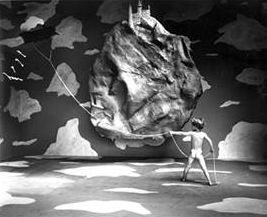
Kim Weston - Zach Flying Kite |
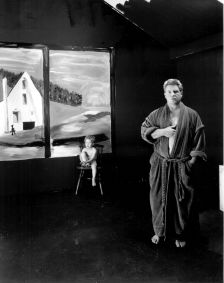
Kim Weston - Self-Portrait with Zach |
KW: disturbing?
BR: very disturbing, not in a Maplethorpe way.
KW: Right exactly, but it’s on the edge.
BR: There’s a lot in there.
KW: Those, to me, are the most rewarding things especially the self-portraits. I really get a kick out of doing them. I really do. Because they, of any of the things I photograph, are the most honest. Because it’s me in the photograph and it’s representing what I’m feeling at that moment. I can’t do tricks with me in front of the camera, I don’t. If I have a bunch of models and stuff I can tweak it I can send messages somewhere else because I’m behind the camera. I’m doing that. But, not when I’m in front of the camera. That’s why I love the portraits so much, self-portraits. It’s an honest straightforward description of what I’m thinking at that time and that one’s great. I did a whole series of Zach and me and a series of my other models and me. Usually at the end of the shoot, I will put myself in the photograph and do a self-portrait and it’s funny, they’re the most telling. I like that. If you’re not going to tell something if you’re not going to expose something it’s real easy to go in and photograph from behind the camera and not expose any of your weaknesses. Getting in front of the camera, to me, does that, I mean you’re vulnerable. I like that. I started out by wanting to feel what it’s like being on the other side of the lens, even though I’m taking the picture. That’s why I love my self-portraits. I’ll always do them. It’s a real honest way to photograph, at least for me.
BR: When we spoke earlier you said your inspiration comes more from painters and painting references than from other photographers. Are you a frustrated painter?
KW: No. The photographer’s work that I look at, maybe I’m missing something, maybe I’m stupid, but their work is done when I look at their photographs. When I look at a painting there is so much left for my interpretation to work with. It’s like they haven’t finished the idea. The painter hasn’t. He’s left it out there very much like you would see in my self-portraits. It’s sort of open ended and it’s left up to your interpretation. It’s much easier for me to take the painting and the image of painters and elaborate them and work on them to fit what I want to say. Where in photography, maybe it’s just because I’ve seen so much photography, I don’t see a photograph anywhere I would elaborate on. It’s different, it’s weird, it’s like I look at photography and I think "uh huh OK, that’s nice" but there’s no fire there. There’s nothing. I can see beauty in work I can see excitement in work but it doesn’t give me anything to grasp onto whereas paintings and looking at paintings does. It gives me something to build on, where photography doesn’t. I look at it. I know it’s good. I don’t know why. That is because photography’s the way it is. But, even my grandfather, I look at his work and I look more back at what he was thinking at the time and what conditions led him to putting a pepper in a funnel and photographing it, more than what the image is to me, maybe because I’m a photographer. Where I’m not a painter even though I paint all my sets and paint the backgrounds and paint all this and draw everything. I tried painting for a short time and realized that I was not a child prodigy at painting. So, I wasn’t going to spend 20 years trying to figure out how to paint when I could already photograph, already express myself reasonably well with a camera. And it took me ever since I was six years old to formulate that. I wasn’t going to spend the 20 years it would take me to learn to paint.
But, yeah, I’m a frustrated painter I guess.
BR: You’ve basically moved into the studio and don’t venture out very often. You described that as freeing you. Would you talk a little more about that?
KW: It is a very liberating experience to work in the studio, for me. My type of lifestyle and my type of personality doesn’t like to go out in the public and is basically very shy. Especially when you’re creating. It’s like writing, When you write you don’t write in Times Square. You write up in some cabin in Nova Scotia in the winter with a bottle of scotch. Nobody’s looking at you. To me that’s what photography is. To be able to release all the information I need to I needed privacy and a place I could do that. It just happened. I think we all search for something that works for us. And that worked for me. I photographed rocks and trees and tide pools and nudes and all that stuff for years and years. Until 20 years ago when I found that I could do it in the studio and never have to travel. Brett was always going to Europe, Mexico. Everyone was always running out photographing. But they’re all running and running away. Edward went to Mexico looking for something. I didn’t want to look for something I wanted to create it from ground up and have everything in that photograph be my decision. Not Mother Nature, not the light, not finding a rock with the right shadow or anything like that. I didn’t want that game. It wasn’t important to me. I wanted everything in the photograph to be me. The studio lends itself perfectly for that. I could create everything or nothing. It’s my job. It’s my job to go down there and work. It’s not jump in a car and go to New Mexico and photograph the pueblos. That’s not exciting to me. I’m not that type of photographer, not the type of artist that does that. I miss it. I don’t see it. Moonrise over Hernandez to me is a lucky shot-- right place, right time, that’s it, nothing more than that. If he was eating his hamburger and passed it by, he would have missed it. I don’t want to miss anything so I want to create it and build it in my studio to my idea.
BR: How good are you at realizing the image you have in your head in your studio on film
KW: That whole process?
BR: Do you get close to what you want?
KW: Real close. But it’s like any art form; surprises come in especially with the thing I do. It’s not like Ansel is sitting there in a quarter mile away from Hernandez saying "Well, shit, if we move this house over there and that house and move the moon down a little bit and the cloud over there." I can do that. I have full control over it. It’s very important for me, that’s why I do what I do, to know what I’m going to end up with or at least a feeling and emotion that travels through. And it’s a learning thing. In front of the camera I look and I see visually what I’ve created. This is after hours of writing it and sketching it and all that. My surprises come usually once I start rolling and photographing. It’s so funny because the back of the camera is nothing more than a place to record what I drew on a piece of paper. It’s not like Brett pulling the dark cloth over his head and looking down Holland Canal "oh shit this is a good one." To me they’re all good and they’re all leading down a path that I’m working on. And I can come back and change it, that’s important for me. I can come back and look at it and say "yeah, I know what I was feeling and the emotion I want to capture" and it usually comes across pretty well because I’m good at it. I’ve done it for years. I usually nail it but there are surprises that pop up that I didn’t see. Those are the little gems. Those are the corners that keep you doing it. Little sort of sparks, you see something in your own self that you didn’t see before in your creativity, something that you over looked.
BR: It sounds like it’s revealing a further level of your own feelings.
KW: Exactly. I think any good art form does that. You work on an idea, your first interpretation is very raw and you work it and you work it and it gets polished and polished. It gets to a certain level and then it comes down off that peak. A lot of times the downside of that peak is your best work. Because anyone that is intuitive with art and works at it, the first initial thing you’re excited about you refine it, refine it, refine it, and get up to the top and then you start questioning yourself on the backside and that’s when you come up with some surprises. At least I do.
BR: It seems like you’re such a radical departure from your Dad and Brett and Edward. They were all out turning the rocks over looking for the next great image.
KW: Yeah, but don’t get me wrong. Look at Edward’s greatest images.
BR: That’s true; Pepper 30.
KW: His nudes. Any nude is a something you setup in front of the camera. Those are the images that he’s remembered for, the shell, all of them, they were things [he staged.] It’s no different than what I do. I just use more people. I use more naked ladies or I do whatever. Those, his most inspirational pieces, were things that he took and put in a situation out of the light of day and photographed them. When you were putting Edward and Dad and Brett [together,] you’ve got to look at Edward and see what he was excited about.
BR: That’s true, it wasn’t the staging in a studio but it was certainly staging.
KW: Staging. Taking a piece of work or an organic figure and photographing it in a different environment. Dad doesn’t do that, except Dad does that with his nudes.
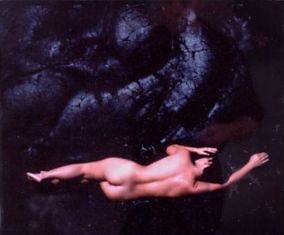
Cole Weston -
Nude
BR: How much did you work with Brett?
KW: I worked a lot with Brett, fifteen years. And it was just a pleasure working with him. I loved being with him his work ethic, his drive his passion. It’s incredible [the way] he lived. If you want to do the thing you’re best at you make a tremendous amount of compromises or you give up a tremendous amount and he did. He gave up everything just for his work and it worked. He loved it. Every day he photographed. Every day, every single day, he photographed. Every day he was in the darkroom. It was a pleasure working with him just being around him. Even though he totally didn’t understand what I was doing-- not a fucking clue. I’d show him my work and we both realized finally that this wasn’t going anywhere. He wasn’t going to understand my work. It’s so funny because I can understand his work and the passion and the drive. But, he was never going to, it’s like some great gap there. He’d say "Well it’s OK Bub, at least you’re working." But, at least he showed interest that I was doing it. A very generous man. [It was] just incredible that I was able to spend that many years with him, not printing but mounting and spotting and doing all that with him, it was fun.
BR: I took a class recently and the photographer that taught the class was talking about what the galleries want and how to get stuff that sells. Brett pretty much made a living off photography his whole life, didn’t he?
KW: Yeah.
BR: And that’s pretty rare.
KW: Yeah. But, not until he really started raking in the dough in his late forties. He was starving before that. He always seemed to have money, somewhat. I remember my uncle as fast cars, fast women and big cameras. He was always sort of making money, but he never really hit it big until his late forties. He worked at things, he was in the army, did all kinds of things.
BR: Do you feel like he consciously compromised in order to make money with his work?
KW: No never, absolutely never.
BR: I don’t feel like Edward really did either. He pretty much did his thing. Once he dumped the portraits.
KW: Of course his portraits were some of his most important work. Not his commercial portraits, but Diego [Rivera] and [José Clemente] Orozco.
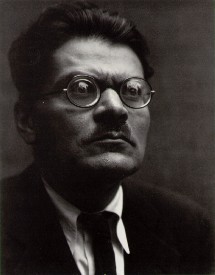
Edward Weston - Portrait of Orozco
If you are going to be in a gallery you might as well bend over and kiss your ass goodbye. And fuck ‘em. Galleries, and they’re all the same, and rightly so, they sell work. It’s like a car dealer, if the model doesn’t work and doesn’t sell you don’t [stock] it. I fit in that category. If no one wants to jump into a Kim Weston and drive it down the street. That’s fine with me I don’t care. I know my work is good and I know it’s serious work.
The gallery is generating work for the masses. You’ve got your biggies, your Strand and Westons and all these different people who are old and dead, which will always sell. You’ve got your new photographers. I always thought I was a new photographer. Well, now I’m an old photographer and I still don’t sell. You know Maggie sold that one image of Calla Lilies in New York. She sold four of them and made a ton of money, over ten thousand bucks on those. It was like if I don’t produce another image like that, that’s comparable and saleable, she doesn’t give a shit about it and what I do. And that’s fine, I don’t disrespect her for that. She has a business to run. There are all kinds of people out there that can produce beautiful landscapes and Michael Kennas, night photography, and moody shit that’s gorgeous, it’s nice stuff beautifully executed and wonderfully printed. That’s not what I do.
BR: Do you think there’s a market that’s difficult to reach that maybe the Internet or some other tool can get to?
KW: No. No, because the galleries drive it. They are the machine. They are the ones that produce. Maggie even said, and she’s right, "I can make you a star." And they can. They can make you or break you. But, you’ve got to play the game and you’ve got to produce what they want for their clients. You know it’s funny, Ron Wohlauer and I were discussing [what would happen] if Edward Weston walked into a gallery today with his work never having been seen before. The Weston gallery, they’d say "Um, send us some slides, we’ll talk to you in six months." Guarantee it. That’s what it would be like. They wouldn’t accept his work. They wouldn’t. Think of one image, Pepper-30, even if you brought that in, a pepper in a funnel. No. Maggie can argue with me that "there’s a great image it stands above" but there’s nothing any different than my Cala Lilies. Bullshit, they would not take him. They would say come back in six months send us some slides.
BR: "We want to see the other 58 pepper shots you made. So we have a body of work on peppers."
KW: Exactly, a body of work, you’re right. It’s true it’s a game and I choose not to play the game. I just love photographing. I don’t do it for anyone else. That’s what Brett taught me. He said "Bub" he said "you do it for yourself." There is the thing with [Brett,] Dad and Edward and the competition and all that. Brett would go "well Bub, the only competition is with yourself." And it’s true.
BR: And yet his images, a lot of them, were quite commercial
KW: Yeah. He was so prolific. He had a great breadth of work that he could do. But the ones he loved were his abstracts that was it. He had a great eye. You could go out with him, and I did many times, photographing and he just had a sense. He had the clearest [vision]. It’s like me when I go into my studio is the only that I could measure it against. He was so clear on what he wanted to see. It was fascinating. I wish he were alive. I’d take you out with him and he would just be sitting there and you’re looking at rocks and trees. And man he would move his camera and say "Bub, come over here" and you’d look in the lens of his camera and he’d nailed it many more times than not. And he had a style. You tune yourself to that style, that look, that way to express yourself. I do it a little more cerebrally with a lot more scary things in it or I work at it a little harder. He had an eye, I was jealous as hell. He could swing that camera around and compose and photograph something with confidence and understanding. His ability to do that was amazing. You would have died. [He had a friend] who traveled a lot with him. Just a second rate bullshit photographer who would come in behind Brett after Brett moved his tripod, put his down, bend the camera over and take the picture. And look at [his] work it’s exactly the same no originality, no nothing.
BR: It seems like that’s sort of an important learning process but you have to move beyond putting your tripod in anybody else’s tripod holes and start to think on your own and see on your own.
KW: I don’t think it happens purposely, you don’t go out to make it happen. Because that screws you up. And I never did. I enjoyed going out and photographing outside and I did some good images but there was something there. People ask me, especially when they look at my work, "It’s so different than any of the other Westons" and "did you do that on purpose?" I felt no pressure that my grandfather was famous and my uncle was famous. I didn’t feel that I had to go out and, image-wise, prove anything. What I had to prove was that I had a dedication and a desire and a passion to do the work and everything else would fall in place because I have a vision that I want to portray and it did and I do it. I don’t sell anything.
BR: Did it occur to you one day that you had the vision or did you kind of have an inkling in the back of your mind from the beginning?
KW: It just happened. Circumstances happened. This is when I was living in Carmel. I had a model I was going to go out and photograph on the beach. It rained and I had a studio so I said "Humm" I got a great model, great studio, bring the mountain to Mohammed. I brought the sand in and that was it ever since. It was such a simple twist of fate. It was like Graham Nash, he was over playing music when he was a kid. Some kid came up to him and said "Hey, come on over the the Mamas and Papas are playing." He didn’t know who in the hell the Mamas and Papas were. After his gig, he was with the Hollys, he said OK and he wandered over with this kid and he met Crosby and Stills. And that was it: Crosby, Stills and Nash. He said it never would have happened unless he walked down that road to the recording studio where the Mamas and Papas were playing. He would have never met that group and it never would have happened. Well it’s the same thing. If the model wasn’t there and the weather wasn’t bad… I’m sure there was something in the back of my brain that said you can do it inside. That was it. I never went outside again.
BR: Since we’re in California, I’ll ask this question. You live in Edward’s old house with Edward’s darkroom pretty much in tact, except for the laser printer.
KW: (laughs) It’s an Apple though.
BR: To me, Edward epitomizes photography in the 20th century. He more than anyone made photography into an art form. I realize he wasn’t alone in that, but he’s the one who stands out to me. This seems like it must be a very inspiring place just to kind of visualize him working here and to know that he spent a lot of hours in that darkroom.
KW: When my Dad bought this property from my uncle I had the opportunity to move here with my then girlfriend. I don’t think at that time I realized how important it was and how important it was for me to be here and carry on that legacy in our family of being a photographer. I can rightly say that, because my passion for the work and my passion to photograph is not equaled by anyone in my generation of Westons. I love it. To me, to know that he was here and I’ve worked so much with his negatives, printing with my Dad and all that, I had a very good basis. He was fascinating to me as a child [and] in my early twenties printing his work and working with my Dad printing his work. Then finally to end up in his house is amazing to a certain extent, but it doesn’t overwhelm me. My Dad and I used to get into huge fights. I don’t see my grandfather as any more important than I am right now. He isn’t. I am as important as he is. If he were alive sitting in that chair today, he would look over at me and say "Hey, keep it up." That’s important to me. It’s important to me to live here in this house and meet the people that want to come and see where he lived and where he worked and [share an] excitement about photography. Hundreds and hundreds of people have visited this place in the ten years I’ve been here with Gina and Zach. None of them has ever been turned away. I’ll sit and listen to any story that they have to tell. To me that’s my enjoyment about living here is that the people constantly coming and saying "Oh, your grandfather was the most inspirational person I ever met or ever saw." I love it because that’s a part of me. That’s my family. It’s a part of my heritage that I’m proud of and respect. Living here is a great plus. It’s great to have the last name Weston, too.
Kim, Edward, and Cole’s work can be seen on Kim's web site www.kimweston.com.
Kim, Edward, Brett, and Cole’s work can also be seen at the Weston Gallery in Carmel or on its web site www.westongallery.com.
Most of Edward’s negatives are stored at the Center for Creative Photography, www.library.arizona.edu/branches/ccp/ccphome.html.
Most of Brett’s negatives were burned by him before his death.
www.masters-of-photography.com provided some of the scans used in this article.